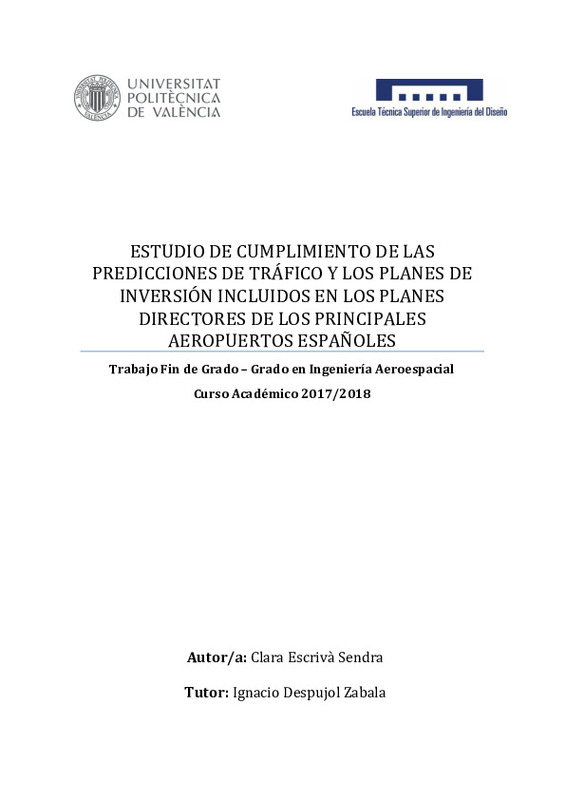|
Resumen:
|
[ES] Hoy en día, los aeropuertos tienen una función que va más allá del transporte. Son
elementos fundamentales de la planificación territorial que condicionan y orientan otros
elementos en función de su importancia ...[+]
[ES] Hoy en día, los aeropuertos tienen una función que va más allá del transporte. Son
elementos fundamentales de la planificación territorial que condicionan y orientan otros
elementos en función de su importancia actual y futura. Además, tienen un gran efecto
sobre el desarrollo local. Por estos motivos, el estudio se basa en analizar el perfil de
los aeropuertos españoles más importantes, seleccionados a partir de su
correspondiente tráfico de pasajeros anual.
El análisis incluirá datos de tráfico reales y su posterior comparación con los valores
previstos en los Planes Directores de dichos aeropuertos. Además, de la situación
financiera de cada aeropuerto en relación de las ampliaciones realizadas y los planes
futuros para la remodelación y mejora de las áreas de servicio de cada aeródromo con
objetivo de mejorar su funcionamiento a largo plazo.
Este estudio permitirá enumerar las causas de fallo en las previsiones de tráfico
incluidas en los Planes Directores, y relacionarlas con inversiones del Estado en
ampliaciones innecesarias.
A lo largo de la lectura, también se incluirán descripciones de diferentes clases de
aeropuertos; estacionales, “fantasma”, regionales, con sus correspondientes
características y análisis de su situación actual. En la sección de aeropuertos regionales,
el estudio se basa en la problemática española de sistemas multi-aeropuerto, que se
traduce a la concentración de un elevado número de aeropuertos en un pequeño radio
de distancia.
El objetivo principal, es generar un perfil aeroportuario español en el que incluir los
principales rasgos de la red de aeródromos en España, con las inversiones destinadas
a cada aeropuerto, sus correspondientes volúmenes de tráfico, las actuaciones
planeadas a largo plazo para abastecer la demanda, la rentabilidad de cada uno de ellos
y otros factores.
[-]
[EN] Nowadays, airports have a function that goes beyond transport. They are fundamental
elements of territorial planning that condition and orient other elements according to their
current and future importance. In ...[+]
[EN] Nowadays, airports have a function that goes beyond transport. They are fundamental
elements of territorial planning that condition and orient other elements according to their
current and future importance. In addition, they have a great effect on local development.
For these reasons, the study is based on analyzing the profile of the most important
Spanish airports, selected from their corresponding annual passenger traffic.
The analysis will include real traffic data and its subsequent comparison with the values
foreseen in the Director Plans of said airports. In addition, the financial situation of each
airport, in relation to the extensions made and future plans for the remodeling and
improvement of the service areas of each aerodrome in order to improve its long-term
operation.
This study will allow to list the causes of failure in the traffic forecasts included in the
Director Plans, and relate them to State investments in unnecessary expansions.
Throughout the reading, descriptions of different kinds of airports will also be included;
seasonal, "ghost", regional, with their corresponding characteristics and analysis of their
current situation. In the section on regional airports, the study is based on the Spanish
problem of multi-airport systems, which translates into the concentration of a large
number of airports within a small radius of distance.
The main objective is to generate a Spanish airport profile in which to include the main
features of the aerodrome network in Spain, with the investments destined to each
airport, their corresponding volumes of traffic, the actions planned in the long term to
supply the demand, the profitability of each of them and many other factors.
[-]
|





![MS Powerpoint file [PP]](/themes/UPV/images/mspowerpoint.png)


